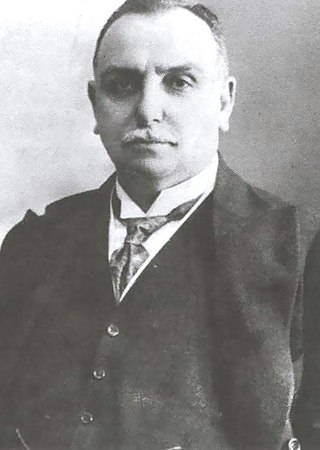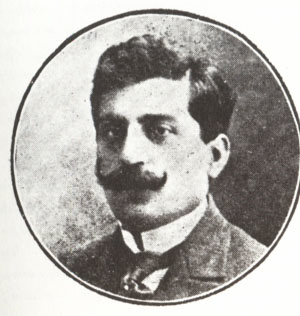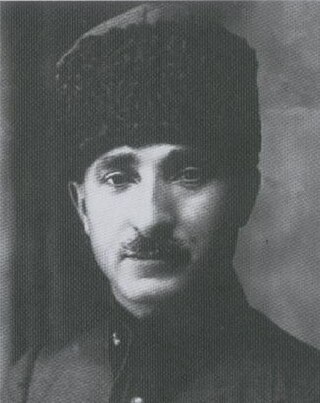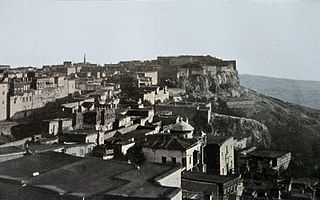Related Research Articles

The Armenian genocide was the systematic destruction of the Armenian people and identity in the Ottoman Empire during World War I. Spearheaded by the ruling Committee of Union and Progress (CUP), it was implemented primarily through the mass murder of around one million Armenians during death marches to the Syrian Desert and the forced Islamization of others, primarily women and children.

The Sayfo or the Seyfo, also known as the Assyrian genocide, was the mass slaughter and deportation of Assyrian/Syriac Christians in southeastern Anatolia and Persia's Azerbaijan province by Ottoman forces and some Kurdish tribes during World War I.
Arapgir is a town and district of Malatya Province, Turkey. As of 2000 it had a population of 17,070 people.

Halil Kut was an Ottoman military commander and politician. He served in the Ottoman Army during World War I, notably taking part in the military campaigns against Russia in the Caucasus and the British in Mesopotamia.

Muş is a city in eastern Turkey. It is the seat of Muş Province and Muş District. Its population is 120,699 (2022). Its population is mostly Kurds.

The deportation of Armenian intellectuals is conventionally held to mark the beginning of the Armenian genocide. Leaders of the Armenian community in the Ottoman capital of Constantinople, and later other locations, were arrested and moved to two holding centers near Angora. The order to do so was given by Minister of the Interior Talaat Pasha on 24 April 1915. On that night, the first wave of 235 to 270 Armenian intellectuals of Constantinople were arrested. With the adoption of the Tehcir Law on 29 May 1915, these detainees were later relocated within the Ottoman Empire; most of them were ultimately killed. More than 80 such as Vrtanes Papazian, Aram Andonian, and Komitas survived.

Aram Manukian, was an Armenian revolutionary, statesman, and a leading member of the Armenian Revolutionary Federation (Dashnaktsutyun) party. He is widely regarded as the founder of the First Republic of Armenia.

Krikor Zohrab was an influential Armenian writer, politician, and lawyer from Constantinople. At the onset of the Armenian genocide he was arrested by the Turkish government and sent to appear before a military court in Diyarbakır. En route, at a locality called Karaköprü or Şeytanderesi on the outskirts of Urfa, he was murdered by a band of known brigands under the leadership of Çerkez Ahmet, Halil and Nazım some time between 15 July and 20 July 1915.
Jevdet Bey or Djevdet Tahir Belbez was an Ottoman Albanian governor of the Van vilayet of the Ottoman Empire during World War I and the Siege of Van. He is considered responsible for the massacres of Armenians in and around Van. Clarence Ussher, a witness to these events, reported that 55,000 Armenians were subsequently killed. He is also considered responsible for massacres of Assyrians in the same region.

Mustafa Yamulki, also known as "Nemrud" Mustafa Pasha, was a Kurdish military officer, chairman of the Ottoman military court, minister for education in the Kingdom of Kurdistan and a journalist. Mustafa was born in the city of Sulaimaniyah which was then in the Mosul Vilayet of the Ottoman Empire.
There is a recognition by several groups of Kurds of the participation of their ancestors in the Armenian genocide during World War I. Some Kurdish tribes, mainly as part of the Ottoman Army, along with the Turks and other people, participated in massacres of Armenians. Other Kurds opposed the genocide, in some cases even hiding or adopting Armenian refugees. Several prominent Kurdish politicians made statements or published articles and books regarding the Armenian genocide.

Vartkes Serengülian, was an Ottoman Armenian political and social activist, and a member of Ottoman Parliament.

Ali İhsan Pasha was the commander for the Sixth Army of the Ottoman Empire during World War I. After the war he was exiled to Malta by the British occupation forces. After returning to Turkey, he was appointed to the commandship of the First Army of Turkey. But shortly before the battle of Dumlupınar, he retired.

George Edward White was an American Congregationalist missionary for the American Board of Commissioners for Foreign Missions for forty-three years. Stationed in the Ottoman Empire during the Armenian genocide as President of the Anatolia College in Merzifon, White attempted to save the lives of many Armenians, including "refused to tell" where Armenians were hiding so to save them from getting deported or killed. Thus he became an important witness to the Armenian Genocide.

Sarkis Minassian, also known as Aram Ashod, was an Armenian journalist, writer, political activist, and educator. He became the chief editor of the newspaper Hairenik in Watertown, Massachusetts. After returning to the Ottoman Empire in 1909, Minassian continued writing in various journals in the city. In 1915, Sarkis Minassian was killed during the Armenian genocide.

Khetcho was a renowned Armenian activist and combatant. A member of the Armenian Revolutionary Federation, Khetcho led an active life in Armenian politic affairs. During his time as an activist, he participated in the Khanasor Expedition, an offensive by Armenian fedayees against the Kurdish Mazrik tribe on July 25, 1897. He was also a key supporter of the Iranian Constitutional Revolution. In 1915, during a skirmish between Turkish forces near Bitlis, he was killed in action.

Grace H. Knapp was an American Christian missionary and teacher who served in the Ottoman Empire. During her time as a missionary, Knapp was a witness to the Armenian genocide. During the Armenian genocide, Knapp was stationed in Van and eventually described the events in the region in two published books describing her experiences. The first book, The Mission at Van in Turkey in War Time, describes in detail the massacres of Armenians by Turkish soldiers during the Van Resistance. Her second book, The Tragedy of Bitlis, relates the narratives of two nurses who witnessed massacres of Armenians in Bitlis. Her recounts of Bitlis are one of the few written accounts of massacres in that area.

Hasan Tahsin Bey was an Ottoman and later Turkish bureaucrat and politician. Throughout his career as a politician, Tahsin served as a governor to several Ottoman cities including Aydın, Erzurum, Van and the province of Syria. Thereafter, he served as deputy to the cities of Ardahan, Erzurum, and Konya. During the Armenian genocide, he was complicit in the Kemah massacres. After the war, he provided important testimony on the genocide.

Harpoot or Kharberd is an ancient town located in the Elazığ Province of Turkey. It now forms a small district of the city of Elazığ. In the late Ottoman period, it fell under the Mamuret-ul-Aziz Vilayet. Artifacts from around 2000 BC have been found in the area. The town is famous for its Harput Castle, and incorporates a museum, old mosques, a church, and the Buzluk (Ice) Cave. Harput is about 700 miles (1,100 km) from Istanbul.

In 1915, a systematic anti-Christian genocide was committed in Diyarbekir vilayet, claiming the lives of most Armenians, Syriac Christians, Greek Orthodox, and Greek Catholics living there. The genocide was ordered by governor Mehmed Reshid, partly with the backing of the CUP Central Committee.
References
- 1 2 Dadrian, Vahakn (1991). Documentation of the Armenian Genocide in Turkish Sources. Institute on the Holocaust and Genocide.
- ↑ Hovannisian, Richard H., ed. (2006). Armenian Tigranakert/Diarbekir and Edessa/Urfa. Costa Mesa, Calif.: Mazda Publ. p. 486. ISBN 1568591535.
- ↑ Kevorkian, Raymond (2011). The Armenian Genocide: A Complete History. I.B.Tauris. p. 327. ISBN 978-1-84885-561-8.
- ↑ Kevorkian, Raymond (2011), p.329
- ↑ Raymond H. Kévorkian, ed. (1995). Revue d'histoire arménienne contemporaine. Paris: Tome 1. p. 254.
- ↑ "Ցեղասպանության ժխտման մեջ Թուրքիայի պաշտոնական պատմագրության 10 հնացած թեզերը". news.am (in Armenian). Retrieved 2023-04-07.